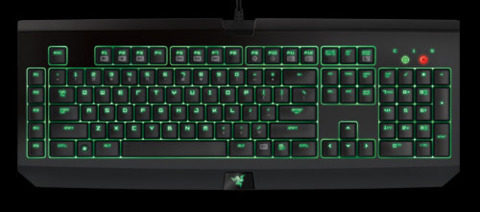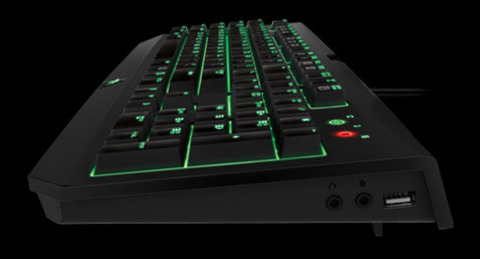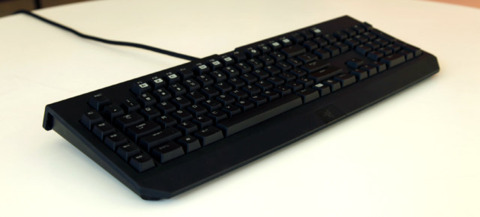Razer's Black Widow Keyboards Get a Much-Needed Face-Lift
Anybody looking for a new gaming keyboard should seriously consider Razer's range of 2013 Black Widow boards, now available in multiple form factors.
Razer is never one to rest on its laurels. The creative force behind some of the PC's most distinct gaming peripherals is pushing a new revision of its most popular keyboard to market: the Black Widow Ultimate 2013. It retains the responsive Cherry MX Blue switches, anti-ghosting capabilities, and on-the-fly macro recording, and it features a new matte finish, complete with Razer-green backlighting. The Black Widow is distinctly Razer and a solid piece of equipment, but like with any other peripheral, it's the details that determine how well it'll fit into your particular hardware ensemble.

The 2013 Black Widow ships in three variations that range from the stripped-down Tournament Edition at $79, to the $139.99 Black Widow Ultimate (Pictured Above).
The Ultimate edition is essentially a mechanical gaming keyboard with extensive macro capabilities, pass-through data and audio ports, media controls, and the ability to register 10 simultaneous keystrokes. Its defining characteristic among the group is the green backlighting that resides underneath each key. On-board key combos allow you to incrementally adjust the brightness through 20 levels of intensity, from way too bright to completely dark.
Where cost is a concern, picking up the standard Black Widow, which forgoes backlighting, can save you $40, coming in at $99.99. For all intents and purposes, it's functionally identical to the Ultimate Edition, just without the backlight option. Unlike past standard Widows, the 2013 version features the same USB and audio pass-through (headphone and microphone) capabilities of the high-end model. If you're right-handed, however, you'll occasionally wish they weren't located on the same side as your mouse hand.
The Tournament Edition, dubbed so for its portability and simplicity, ditches the backlighting, pass-through ports, macro functionality (per competitive gaming regulations), and, most importantly, the number pad, and retails for $79.99. Interestingly, it features a detachable USB cable, a feature not found in other Widow models. It's a new form factor for the Black Widow line, and considering the heft of the full-size models, it's one that will strike a chord with participants at LAN parties and other BYOC (bring your own computer) events.
The hallmark feature of any Black Widow is the Cherry MX switches within each key. The benefits of their mechanical design, relative to the all-too-common rubber-membrane design, are immediately recognizable. Mechanical keys in general require less pressure to actuate, rapidly spring back to their neutral position, and often exhibit some form of sensory feedback. During gameplay, the ability to quickly strike a key and confirm actuation is an invaluable tool. The same qualities make general typing an overall easier experience, too. Cheap manufacturers tend to use the membrane standard, resulting in mushier strokes, which in turn, requires excessive force to actuate a key. Once you've grown accustomed to the bounciness and ease of striking a mechanical key, it's challenging to return to a membrane-based keyboard and not feel like you're using a lesser product.
The same can be said for the Black Widow. If you aren't accustomed to it, the noise and responsiveness feel wholly different at first. The sound of a Widow's click is crisp and anything but quiet, but it grows on you. It's only after spending a significant number of hours with the Widow that it begins to feel "right." General typing even becomes less of a physical burden on the hands. That alone makes it (and mechanical keyboards in general) worth considering, regardless of their application.
Many users criticized last year's Widows for the glossy finish, which had the unfortunate ability to hold onto fingerprints like a champ, so it's great to see that problem resolved across all models. They're more utilitarian in appearance, but that isn't necessarily a bad thing.
 Recording macros within and without Razer's Synapse 2.0 configuration software is a simple and intuitive task. The straightforward GUI allows you to name your macro, define key-press delay recordings, and visually confirm your macro inputs prior to saving. To assign your macros to a key, you must shift to the "Keyboard" configuration tab and choose the desired key on the rendered image of the Black Widow.
Recording macros within and without Razer's Synapse 2.0 configuration software is a simple and intuitive task. The straightforward GUI allows you to name your macro, define key-press delay recordings, and visually confirm your macro inputs prior to saving. To assign your macros to a key, you must shift to the "Keyboard" configuration tab and choose the desired key on the rendered image of the Black Widow.
Recording on the fly is easier, though slightly less flexible, than using Synapse. Pressing the FN (function) and F9 keys initiates the macro recording mode, signified by a red, backlit icon above the number pad. From there, simply enter your desired key combo and press the FN/F9 keys once more to end the recording. The final step is to assign the macro to a key on the keyboard, accomplished by hitting said key as the red macro notification flashes. When the recording is complete, the macro icon shuts off, and your macro key is ready to use.
It's an easy procedure to carry out, but adjusting your macros requires some extra work. By default, on-the-fly recordings take the delay between key presses and depresses into account. Once a macro is set, you can modify these nuances through Synapse, deleting delays or modifying their duration as you see fit. The designated row of macro keys is easily accessible, but if you find that you need more than five macros at any given time, you can assign them to any key on the board through Synapse as well.
The Widow's "gaming mode" is a useful feature that disables certain key combos to prevent inadvertent gameplay interruptions. By default, the Windows key will be disabled, but you can add ALT+F4 and ALT+TAB to that list within Synapse. Enabling gaming mode, according to Razer, also kicks the 10-key rollover into gear, but we found the Widow adept at registering 10 simultaneous key strokes with or without gaming mode enabled, to Razer's credit.

All told, the refreshed Widow has upped the bar set by prior models. The Ultimate version tips the scales at $140, but it's functionally rich, and if you crave backlighting, it's the Widow for you. Though it lacks fancy additions such as secondary displays and multicolor LEDs, it lives up to Razer's promise of a high-end keyboard with features that the gaming crowd actually wants, namely, mechanical keys, macros, and anti-ghosting capabilities. It's great that Razer has improved one of its flagship products based on user feedback, especially by generously including audio and data capabilities on the standard model. Other than the potential annoyance regarding pass-through port placement, there's so much to like about the Widow. With almost no faults to speak of, it deserves to be at the top of your shopping list when upgrading your gaming arsenal.
Got a news tip or want to contact us directly? Email news@gamespot.com

Join the conversation